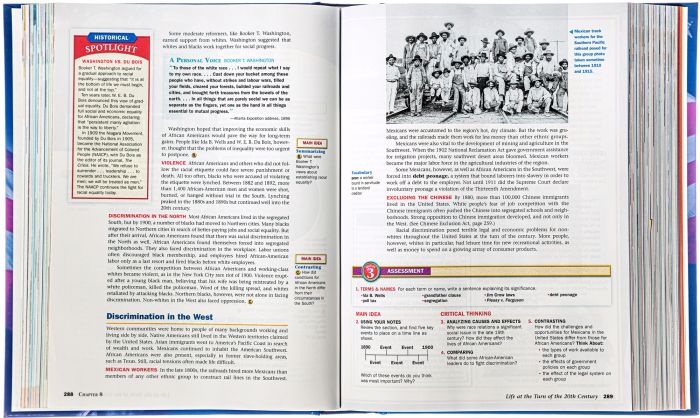Unveiling the modern world history textbook answers, this comprehensive guide delves into the intricacies of historical education, equipping readers with a profound understanding of the past and its impact on the present. This guide provides a roadmap to navigate the complexities of modern world history textbooks, empowering students and educators alike to critically engage with historical narratives and develop a nuanced understanding of the world around us.
Throughout this exploration, we will delve into the significance of textbooks in shaping our comprehension of the past, uncover the key historical periods and events that define the modern world, and examine the geographic regions that have played pivotal roles in shaping human history.
We will also investigate the crucial distinction between primary and secondary sources, unravel the complexities of historiography, and emphasize the importance of developing critical thinking skills in the study of history.
Introduction
Textbooks play a crucial role in modern world history education by providing students with a comprehensive and structured understanding of the past. They offer a framework for understanding the complex events, themes, and connections that have shaped the world we live in today.
Modern world history textbooks aim to present a balanced and comprehensive account of global history, covering a wide range of topics from ancient civilizations to the present day. They provide students with the knowledge and skills necessary to critically analyze historical events and develop informed opinions on contemporary issues.
Key Historical Periods: Modern World History Textbook Answers
Modern world history textbooks typically divide history into several major periods, each characterized by distinct events and themes.
Ancient World
- Rise of civilizations in Mesopotamia, Egypt, India, and China
- Development of writing, mathematics, and science
- Emergence of empires and the spread of ideas and technologies
Classical World
- Growth of the Greek and Roman empires
- Advancements in philosophy, literature, and art
- Spread of Christianity and the rise of monotheism
Middle Ages
- Fall of the Roman Empire and the rise of feudalism
- Spread of Islam and the establishment of Islamic empires
- Development of trade and commerce, leading to the rise of cities
Early Modern World
- Age of Exploration and the rise of European colonialism
- Scientific Revolution and the Enlightenment
- Industrial Revolution and the emergence of nation-states
Modern World
- World Wars I and II
- Cold War and the rise of superpowers
- Decolonization and the emergence of new nations
- Technological advancements and globalization
Geographic Focus
Modern world history textbooks typically cover a wide range of geographic regions, with a focus on areas that have played a significant role in global events.
Europe
- Birthplace of Western civilization
- Major center of political, economic, and cultural development
- Influence on global affairs through colonialism and imperialism
Asia
- Home to ancient civilizations and major world religions
- Center of trade and cultural exchange along the Silk Road
- Significant role in modern world events, including decolonization and economic growth
Africa, Modern world history textbook answers
- Cradle of humanity and the site of early civilizations
- Exploited by European colonialism
- Experiences of decolonization and the challenges of nation-building
Americas
- Home to indigenous civilizations before European colonization
- Site of major revolutions and the emergence of new nations
- Influence on global affairs through economic and military power
Primary and Secondary Sources

Modern world history textbooks rely on both primary and secondary sources to provide students with a comprehensive understanding of the past.
Primary Sources
- First-hand accounts of events, such as letters, diaries, and speeches
- Provide valuable insights into the thoughts and experiences of people who lived during the period being studied
- Examples: Declaration of Independence, eyewitness accounts of battles
Secondary Sources
- Works written after the events they describe, based on research and interpretation of primary sources
- Provide a broader perspective and analysis of historical events
- Examples: Textbooks, historical monographs, documentaries
Historiography

Historiography is the study of the writing of history, including the methods and interpretations used by historians.
It is important because it helps students understand how historical knowledge is constructed and how different perspectives can shape our understanding of the past.
Schools of Thought
- Positivism: Focuses on objective facts and empirical evidence
- Marxism: Emphasizes the role of economic and social factors in shaping history
- Postmodernism: Questions the objectivity of historical knowledge and emphasizes the role of language and power
Critical Thinking Skills

Modern world history textbooks play a vital role in developing students’ critical thinking skills.
By examining multiple perspectives, analyzing primary sources, and considering the context of historical events, students learn to:
- Evaluate evidence and draw informed conclusions
- Identify biases and propaganda
- Understand the complexity of historical issues
- Develop their own informed opinions
FAQs
What is the purpose of a modern world history textbook?
Modern world history textbooks provide a comprehensive overview of the major historical events, themes, and figures that have shaped the modern world, from the late 15th century to the present day.
How can I use textbooks to develop critical thinking skills?
Textbooks often include primary source documents, discussion questions, and historiographical debates that encourage students to analyze evidence, evaluate different perspectives, and form their own interpretations of historical events.
What is the difference between primary and secondary sources?
Primary sources are firsthand accounts of historical events, such as letters, diaries, and government documents, while secondary sources are works that interpret or analyze primary sources.